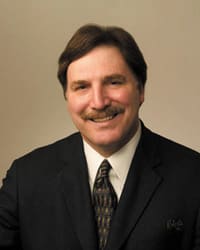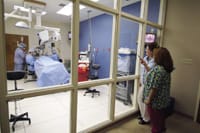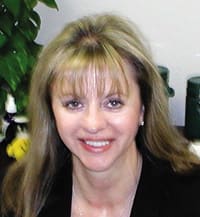The Evolution Of an ASC
Surgeons have a stake in the success of this long-standing
ASC. Here's how the
practice has stayed ahead
of the curve.

The Abilene Eye Institute in West Texas differentiates itself by providing a combination of the latest techniques and technology with the classic standards of high quality and good value. Our ambulatory surgery center (ASC) has been around long enough to bear witness to the rewards inherent in our commitment to quality. We're certain the quality of our 'product' fosters word-of-mouth recommendations to patients and referring physicians.
Unlike other administrative methods, where proof of the model's efficacy can be quantified, when the foundation of a surgery center is quality, you either believe in the strength of your philosophy of providing the best -- or you don't. You must have faith that providing quality care is reward enough. More often than not, your commitment to quality will be recognized and rewarded by increased volume.
Full-service ASC
Our practice, founded by Robert Cameron, M.D., began as Eye Medical Associates of Abilene in 1976. Recognizing a need, Dr. Cameron began performing outpatient surgery in the hospital setting in 1982. I joined him the following year, and we opened a new office. In 1987, our second new office opened as the Abilene Eye Institute with a Medicare-approved two-OR ASC attached, and it's been a surgeon-owned facility since then.
In 1997, we sold a 51% share in the ASC to AMSURG, a company that partners with single-specialty surgery centers. The relationship, which has been a positive one from the start, provides economies of scale, as well as other administrative benefits.
Since we began, our mission has been to provide patients with the most innovative medical and surgical eyecare solutions available. West Texans are forward-thinking, knowledgeable people who readily seek out and accept new developments in medical and surgical treatment. Abilene and the surrounding area is a stable, slowly growing community with new construction principally to the south. We have a limited number of large employers and a relatively low rate of managed care penetration. All of these factors influence our growth.
Initially, our emphasis was on anterior segment surgery, medical and surgical glaucoma and medical retina. In recent years, we've expanded into the refractive surgery and posterior segment subspecialties. In addition, a local plastic surgeon also operates in the facility.
Supplier Support
Cuts in reimbursement have resulted in the further need to improve efficiency and quality. Our acquisition of new Alcon phaco-emulsification technology in recent years has rapidly improved our OR efficiency, and our current relationship with the company has proved an effective means to that end.
Active relationships with our suppliers give us early access to developing technologies. Sales support and service are the unsung heroes of an ASC's success. An outstanding company representative, just like a trusted staff member, knows your center and anticipates its needs. This person will know your skills and interests and can be an invaluable asset to your practice.
Input from suppliers is an important part of our decision-making process with respect to new technology purchases, but networking with forward-thinking surgeons around the country and the world is essential, as well. We also actively participate in meetings related to new developments.
All of the surgeons involved in The Abilene Eye Institute have a say in new equipment choices because we all have a stake in these choices. We make decisions by consensus, along with the appropriate amount of input from AMSURG. The decision of when to incorporate a new technology is based on whether or not we believe it will significantly advance our outcome quality or efficiency. Substantial improvement in either, we believe, eventually will offset or overcome the cost of the new technology. Furthermore, it's quite a bit more stimulating to be part of a practice that's always improving.
While cost plays a part in the decision-making process, it's not the leading factor and never the sole criterion. We opt for less expensive purchases only when we feel they provide comparable or superior results or efficiencies. Product bundling is a critical means of maintaining high quality and still attaining cost savings and efficiency.
Successful Formula
Our use of Alcon's AcrySof IOL, which offers the benefit of a reduced YAG rate, is another way that we show our commitment to quality. I consider the elimination of the need for YAG laser capsulotomy a goal of the great majority of ophthalmologists. I irrigate, polish and use the best lens I can to reduce the likelihood of posterior capsule opacity. Although YAG capsulotomy is a common and 'expected' mild post-cataract 'complication,' it's inconvenient, and although it's very rarely dangerous, it's always an incredible drain on the limited Medicare resource. We see our use of the AcrySof IOL as part of a winning formula: Fewer YAGs equal higher quality, and higher quality equals happier, healthier patients, which equals more volume. Any reduction in revenue realized from performing fewer YAGs is more than made up for in increased volume. The negligible loss is overshadowed by satisfied patients and physicians who strive for quality rather than rationalize its absence.
Another example of our quality choices is single-use disposable packs. Efficiencies in ordering, purchasing and application allow us to use these cost effectively even though we spent most of the last 17 years reasonably happy with reusable tubing. The only serious problem we had with reusable tubing occurred in the mid-1980s when we saw three consecutive cases of low-grade sterile endophthalmitis due to Pseudomonas endotoxin contamination of a rinsing solution. All three patients recovered 20/20 vision, but the incident clearly demonstrated a potential risk.
Additionally, faster, more efficient surgery has eroded the time available for proper care of reusables. The only reusables that remain in our armamentarium are our instruments, including diamond knives. We rarely use special disposable aids such as iris hook pupil stretchers or capsulorhexis aids.
|
|
Advancing With the Times |
|
Our facility's commitment to the advances in techniques and technologies has had a tremendous influence on our growth. We began performing phacoemulsification and IOL implantation routinely in 1976. We incorporated circular tear capsulorhexis around 1985 and injectable foldable IOLs in 1988. Lateral clear corneal incisions or 'near clear' lateral limbal incisions followed in 1993, and we added topical anesthesia and topical plus intracameral anesthesia in 1995. We aided in the development of IOL delivery systems in 1995 and 1996 and see them as one of the most elegant and effective devices available. |
Instrument Consensus
Shared ownership among our surgeons instills an interest in obtaining cost and efficiency savings. As a result, we develop a consensus choice of instruments for each procedure type.
Our cataract techniques are very similar, with only minor differences in microscope and machine settings and phaco tips. Our reputation for quality outcomes and the use of the newest surgical advances has armed our prospective cataract patients with exceedingly high expectations. Today, some patients think 20/20 isn't good enough. Fortunately, what we've learned in refractive surgery enables us to address these quality-of-vision issues. We use two different wavefront analyzers routinely to detect and treat these problems, and I've used LASIK and conductive keratoplasty as no-charge enhancements to improve a cataract surgery outcome.
Partnering with a premium products company requires that quality, consistency and efficiency are included in that premium. Without these, no center can afford a 'partnership' such as this. Admittedly, in the fixed reimbursement world, without an increase in volume, the bottom line may suffer some. However, the satisfaction of the patients and physicians is a dividend that really can't be measured by the bottom line.
We've never had to use a strictly cost-based approach to be a profitable center. Improved machine safety and efficiency made a case for a disposable tubing and pack option to improve outcome quality. Financing and bundling efficiencies have improved as well. Quality of the patients' outcomes and experience have and can be reached by other means, but in our hands we have found this route the most satisfying.
Dr. Thames practices at the Abilene Eye Institute Cataract & Refractive Surgery Center in Abilene, Texas.
|
Unique Marketing Strategy |
One of our most effective internal marketing strategies resulted from Dr. Cameron's visit with Howard Gimbel, M.D., in Canada in the mid-1980s. Dr. Cameron was intrigued by the Canadian surgeon's observation area, so we incorporated a glass-walled OR observation room in our ASC when it was constructed. It's the single best internal marketing decision we've ever made. Families are offered -- and almost universally accept -- the invitation to watch their loved one's surgery with a direct view through the glass wall, as well as with a monitor of the surgeon's view. Making surgery open and visible to patients and their families fosters trust and confidence in us as surgeons and eliminates anxiety. When these patients and their families take those feelings out into the community, the rewards we reap in good will and recommendations cannot be quantified. |
|
Deciding for Disposables |
With a total of 16 offices and nine ambulatory surgery centers (ASCs), Barnet Dulaney Perkins Eye Center (BDPEC) is the largest eyecare practice in Arizona. As director of operations, I'm committed to controlling costs, but I understand that keeping patients safe from infections and cross-contamination is infinitely more important than saving money. Like so many other practices, we were lulled by the relatively low price of reusable products, without really considering the hidden costs. Electricity for the sterilizer, indicator strips, water maintenance and packaging all contribute to cost per use. Less tangible, but no less costly, was the time our staff was spending cleaning and processing products. Upon review, we realized we were devoting enormous financial and staff resources to maintaining a sterile supply of reusable instruments. What's more, we're not always sure these items will function properly. Reusable tubing, for example, can develop holes or get clogged if it's not cleaned properly, resulting in wasted OR, surgeon and anesthesia time if it must be replaced during surgery. In an effort to minimize our costs without endangering our patients, we began investigating the pros and cons of single-use devices. Compared with the price of reusable devices, single-use items appear more expensive -- until you consider safety and convenience. Because every product is used only once, patients are less likely to contract infections from poorly cleaned products. Single-use devices also eliminate the time and labor costs arising from the cleaning process. As we continue our switch to single-use devices, our staff is happier, too. Instead of spending long hours at the end of the day processing instruments and tubing, they can go home and return refreshed for the next day's cases. Disposable materials do have their downside -- they take up more space in the OR and increase the apparent cost per case -- but the convenience of readily available, sterile, single-use devices far outweighs the upfront cost and other incidental shortcomings of these products. I'd advise any administrator thinking about switching to single-use devices to review the upfront price and the hidden costs of reusables versus the convenience, safety and long-term advantages of disposables. We've done so well with single-use products, we wish we'd made the switch sooner.
|










